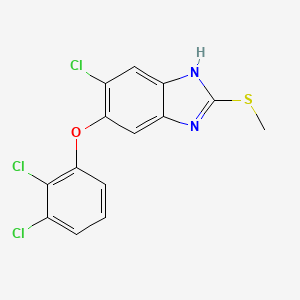D1138 | triclabendazole
P
P02BX04 Triclabendazole
[P02BX] Other antitrematodal agents
[P02B] ANTITREMATODALS
[P02] ANTHELMINTICS
[P] Antiparasitic products, insecticides and repellents
| Toxicity | Dose | Time | Species | Model | Method | Action | Positive criterion | Reference |
|---|---|---|---|---|---|---|---|---|
| MEMBRANE POTENTIAL | 1.84±0.15 | human | qHTS-HepG2 | MMP assay | decrease | IC50 | 163 | |
| MEMBRANE POTENTIAL | 5.48 | human | HepG2 | MMP assay | decrease | IC50 | 163 | |
| MEMBRANE POTENTIAL | 15.55±2.52 | rat | hepatocytes | MMP assay | decrease | IC50 | 163 | |
| Pictogram | Signal | Statements | Precautionary Statement Codes |
|---|---|---|---|
 |
Warning |
Aggregated GHS information provided by 79 companies from 6 notifications to the ECHA C&L Inventory. Reported as not meeting GHS hazard criteria by 41 of 79 companies. For more detailed information, please visit ECHA C&L website Of the 4 notification(s) provided by 38 of 79 companies with hazard statement code(s): H373 (92.11%): Causes damage to organs through prolonged or repeated exposure [Warning Specific target organ toxicity, repeated exposure] Information may vary between notifications depending on impurities, additives, and other factors. The percentage value in parenthesis indicates the notified classification ratio from companies that provide hazard codes. Only hazard codes with percentage values above 10% are shown. |
P260, P314, and P501; (The corresponding statement to each P-code can be found at the GHS Classification page.) |
| 1H-BENZIMIDAZOLE, 5-CHLORO-6-(2,3-DICHLOROPHENOXY)-2-(METHYLTHIO)- | 1H-Benzimidazole, 6-chloro-5-(2,3-dichlorophenoxy)-2-(methylthio)- | 4784C8E03O |
| 5-Chloro-6-(2,3-dichlorophenoxy)-2-(methylsulfanyl)-1H-benzimidazole | 5-Chloro-6-(2,3-dichlorophenoxy)-2-(methylthio)-1H-benzimidazole | 5-Chloro-6-(2,3-dichlorophenoxy)-2-(methylthio)benzimidazole |
| 5-[2,3-bis(chloranyl)phenoxy]-6-chloranyl-2-methylsulfanyl-1H-benzimidazole | 5-chloro-6-(2,3-dichlorophenoxy)-2-(methylthio)-1H-benzo[d]imidazole | 5-chloro-6-(2,3-dichlorophenoxy)-2-methylsulfanyl-1H-benzimidazole |
| 6-CHLORO-5-(2,3-DICHLOROPHENOXY)-2-METHYLTHIO-BENZ | 6-Chloro-5-(2,3-dichlorophenoxy)-2-(methylthio)-1H-benzo[d]imidazole | 6-Chloro-5-(2,3-dichlorophenoxy)-2-(methylthio)benzimidazole |
| 6-Chloro-5-(2,3-dichlorophenoxy)-2-methylthio-benzimidazole | 6-chloro-5-(2,3-dichlorophenoxy)-2-(methylsulfanyl)-1H-1,3-benzodiazole | 6-chloro-5-(2,3-dichlorophenoxy)-2-(methylsulfanyl)-1H-benzimidazole |
| 6-chloro-5-(2,3-dichlorophenoxy)-2-(methylthio)-1H-benzimidazole | 6-chloro-5-(2,3-dichlorophenoxy)-2-methylsulfanyl-1H-benzimidazole | 6-chloro-5-(2,3-dichlorophenoxy)-2-methylthiobenzimidazole |
| 68786-66-3 | 786T663 | A836250 |
| AB0013427 | AB00639964-10 | AB00639964_12 |
| AB00639964_13 | AB1004580 | AC-7627 |
| AK-68238 | AKOS005439340 | AKOS015950804 |
| ANW-42745 | API0004496 | AX8034628 |
| BDBM58491 | BEN631 | BR-68238 |
| BRD-K81916719-001-05-5 | C14H9Cl3N2OS | CAS-68786-66-3 |
| CCG-100881 | CCRIS 8988 | CGA 89317 |
| CGA-89317 | CGA89317 | CHEBI:94759 |
| CHEMBL1086440 | CPD000466357 | CS-2859 |
| CTK5C8452 | D07364 | DB12245 |
| DSSTox_CID_23952 | DSSTox_GSID_43952 | DSSTox_RID_80094 |
| DTXSID7043952 | EGA230B | Egaten |
| Egaten (TN) | FT-0602564 | Fasinex |
| Fasinex (TN) | HMS2051E16 | HMS2232D14 |
| HMS3370H02 | HMS3393E16 | HMS3652M16 |
| HMS3715P16 | HMS3744I09 | HY-B0621 |
| I018 | KS-00000KPE | KS-5329 |
| KUC103451N | LS-32758 | MCULE-8131756770 |
| MLS000759473 | MLS000876812 | MLS001424101 |
| MP-0274 | NC00131 | NCGC00164610-01 |
| NCGC00164610-02 | NQPDXQQQCQDHHW-UHFFFAOYSA-N | NSC-759250 |
| NSC759250 | NVP-EGA230 | Oprea1_236106 |
| Pharmakon1600-01505786 | Q419739 | SAM001246681 |
| SB17173 | SBI-0207022.P001 | SC-17720 |
| SCHEMBL165712 | SMR000466357 | SR-01000759363 |
| SR-01000759363-4 | ST2418930 | STK332284 |
| SW197511-2 | TR-022940 | Tox21_112231 |
| Triclabendazol | Triclabendazol [INN-Spanish] | Triclabendazole |
| Triclabendazole (USAN/INN) | Triclabendazole [BAN:INN] | Triclabendazole [USAN:INN:BAN] |
| Triclabendazole for system suitability, EuropePharmacopoeia (EP) Reference Standard; | Triclabendazole, 98% | Triclabendazole, EuropePharmacopoeia (EP) Reference Standard |
| Triclabendazole, VETRANAL(TM), analytical standard | Triclabendazolum | Triclabendazolum [INN-Latin] |
| UNII-4784C8E03O | ZINC1444556 | cid_50248 |
| s4114 |

